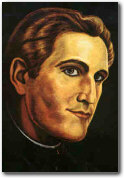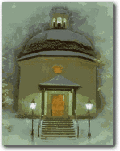"Silent Night", which has been translated
into nearly 300 languages, has become an anchor for Christmas celebrations throughout the
world. Its lullaby-like melody and simple message of heavenly peace can be heard from
small town street corners in mid-America to magnificent cathedrals in Europe and from
outdoor candlelight concerts in Australia to palm thatched huts in northern Peru.
Although we may
never know the exact circumstances and emotions which inspired Joseph Mohr to write his
poem, we do know that he wrote the words in 1816. At that time he was assigned to a
pilgrimage church in Mariapfarr, an Alpine village near the home of his grandfather in the
southern part of the province of Salzburg, Austria.
We hear many fairytales concerning the composition of what has
become the world's best loved Christmas carol. These include silly stories about mice
eating the bellows of the organ and Fr. Mohr being forced to quickly composesome words for
a new carol so there could be music at Midnight Mass.
 Did mice really chew the organ bellows and thus
prevent it from working on
Did mice really chew the organ bellows and thus
prevent it from working on
Christmas Eve in 1818? Probably not. Hungry mice were an ongoing problem in the
harsh winter environment of an unheated church and repairs could be easily made to organ
bellows. A Franz Gruber sketch of mice nibbling the organ bellows has been published in
several book.
Some historians feel that the constant flooding of the Salzach
River in Oberndorf, Austria caused rust and mildew in the organ. Others think that Joseph
Mohr simply wanted a new song for the Christmas service.